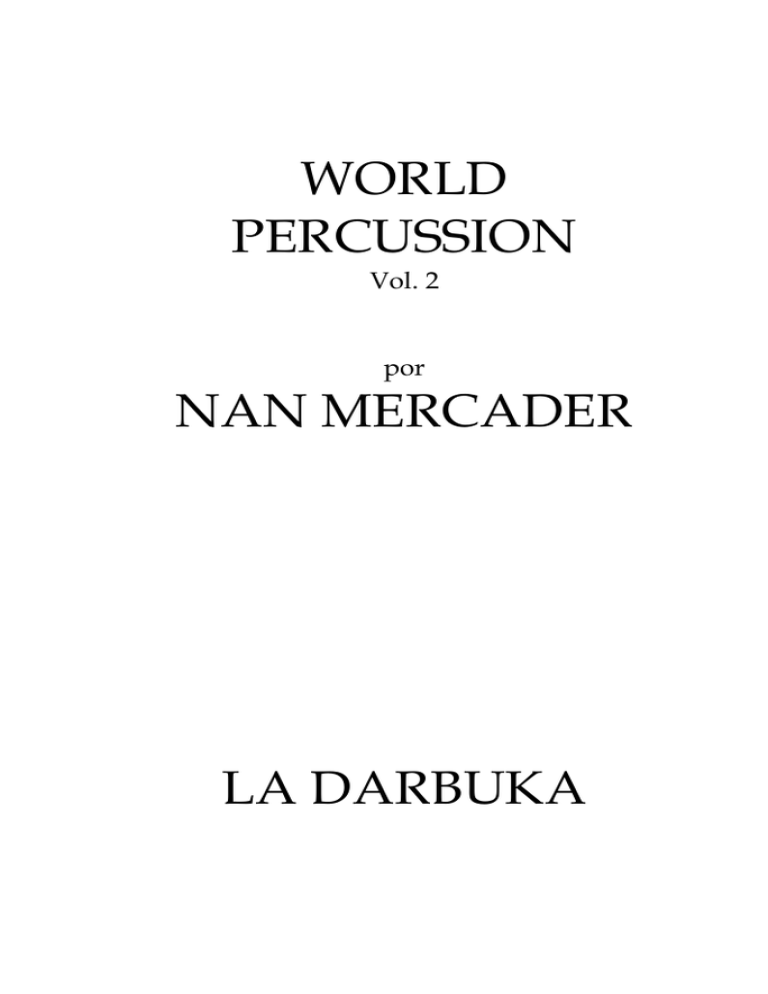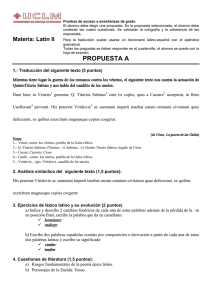Llibre DVA002.cdr
Anuncio

WORLD PERCUSSION Vol. 2 por NAN MERCADER LA DARBUKA Queda rigurosamente prohibido, sin la autorización escrita de los titulares del Copyright, bajo las sanciones establecidas por las leyes, la reproducción total o parcial de esta obra por cualquier medio o procedimiento, o su incorporación a un sistema informático, ni su transmisión en cualquier otra forma o por cualquier otro medio, sea éste electrónico, mecánico, reprográfico, etc... No part of this book may be reproduced, stored in a retrieval system, or transmitted in any form, by any means, including mechanical, electronic, photocopying, recording, or otherwise, without prior written consent of the titleholder of the copyright. Copyright 2005 by Nan Mercader Copyright 2005 by Desarrollo de Contenidos Audiovisuales, s.l. Edita: VENTILADOR MUSIC C/. Rossend Arús, 9 · 08014 BARCELONA (SPAIN) Tel. 93 432 32 08 FAX: 93 432 33 27 www.ventilador-music.com D.L.: B-8.379/2005 ÍNDICE La Darbuka ................................................................................... Consejos al realizar la compra de una Darbuka ..................... Consejos prácticos / Trabajo personal ..................................... Trabajo colectivo / La Tribu ...................................................... 5 5 7 9 Ejercicios: Sonidos Leyenda ....................................................................... Dum y Tak .................................................................... Dum y Galleta .............................................................. Dum, Tak y Galleta ..................................................... Blocajes .......................................................................... Nuqfa ............................................................................. Ornamentación ............................................................ Ras de Cinco ................................................................. Cambios del Dum ........................................................ Progresiones ................................................................. 12 13 14 15 15 16 16 17 17 18 Ejercicios: Ritmos árabes Ayyub / Karachi .......................................................... Masmudi Kabir ............................................................ Fezzani o Fallahy / Barwali ....................................... Maqsoum / Kalamatiano ........................................... Cinco Turco / Shish Hast............................................ Karsilama ...................................................................... 19 20 21 22 23 24 Ejercicios: Ritmos World Rock / Hip-Hop / Funk / Habanera........................ 25 Créditos ......................................................................................... 26 INDEX The Darbuka ................................................................................ Advice when buying a Darbuka ............................................... Practical advice / Individual study ......................................... Group work / The Tribe ............................................................ 6 6 8 10 Exercises: Songs Sounds .......................................................................... Dum & Tak ................................................................... Dum & Slap .................................................................. Dum, Tak & Slap ......................................................... Block .............................................................................. Nuqfa ............................................................................. Ornamentation ............................................................. Ras Five ......................................................................... Dum Changes ............................................................... Progressions ................................................................. 12 13 14 15 15 16 16 17 17 18 Exercises: Arabian Rhytms Ayyub / Karachi .......................................................... 19 Masmudi Kabir ............................................................ 20 Fezzani or Fallahy / Barwali ...................................... 21 Maqsoum / Kalamatiano ........................................... 22 Turckysh Five / Shish Hast............................................ 23 Karsilama ...................................................................... 24 Exercises: World Rhytms Rock / Hip-Hop / Funk / Habanera........................ 25 Credits ........................................................................................... 26 LA DARBUKA La Darbuka es el instrumento de percusión más representativo de la zona norte de Africa, Oriente Medio y Mediterráneo oriental. Se le llama Derbuka en Marruecos, Derbake en Turquía, Tabla en Egipto. Tabla es un nombre común que significa tambor. Es un instrumento que antiguamente se construía en madera o cerámica y piel de cabra o de pescado. Se utiliza tanto en la música tradicional árabe, en orquestas de música árabe, como para acompañar los famosos bailes o danzas del vientre aunque actualmente se toca en muchísimos grupos de world music, música pop y rock. Consejos al realizar la compra de una Darbuka Sería aconsejable comprar como primer instrumento una darbuka metálica y con el parche de plástico. Las Darbukas de cerámica son muy frágiles y los parches de piel o pescado son poco adecuados para los países fríos ya que la humedad destensa las pieles. Debemos asegurarnos que las aristas del parche estén bien redondeadas y uniformes para poder golpear con comodidad. Comprobar que le tambor tiene una buena tensión y que aun podemos subir un poco mas los tensores. El tambor ideal para trabajar según la técnica que se muestra en este método es el egipcio, algo mas pesado y consistente que el turco, mas idóneo para tocar entre las piernas. Mas adelante puedes adquirir una Darbuka de cerámica y piel de pescado para disfrutar de su estética y sonido en ocasiones especiales El Rik o pandereta árabe es el tambor complementario a la Darbuka en muchos de los ritmos árabes. También el Daf, Tar y Bendir se tocan simultáneamente con la Darbuka. 6 THE DARBUKA The Darbuka is the most representative percussion instrument in the northern part of Africa, the Middle East and the western Mediterranean. It is called the Derbuka in Morocco, Derbake in Turkey, and Tabla in Egypt. Tabla is a common name meaning drum. In past times it was made from wood or ceramics and goat or fishskin. It is used as much in traditional Arab music, as it is to accompany Belly dancing, although nowadays it is played in many world music and pop and rock groups. Tip on buying a Darbuka It is best to begin by buying a metal Darbuka, with a plastic drumhead, as a first instrument. The ceramic Darbukas are very fragile and the goat and fish-skin heads are not the most appropriate for cooler countries given that the humidity slackens the skin tension. We should be sure that the skin's edges are well rounded and uniform so as to be able to strike the drum comfortably. Be sure that the drum is well tensioned and that the tensors could still be raised a little more. The ideal drum for working the techniques shown here is the Egyptian model, somewhat heavier and more solid than the Turkish drum, and better for playing between the legs. Later on you can buy a ceramic, fish-skin model, to enjoy both the aesthetics and the sound, on special occasions. The Rik or Arab Tambourine is the complementary instrument to the Darbuka in many Arab rhythms. The Daf, Tar and Bendir are also played alongside the Darbuka. 7 CONSEJOS PRÁCTICOS - TRABAJO PERSONAL Si quieres avanzar rápidamente en el aprendizaje del toque de la Darbuka practica cada día como mínimo 30 minutos. Es mejor esto que practicar una hora cada dos días. Empieza con unos ejercicios para los dedos, golpea primero con el dedo gordo, después con el indice y así sucesivamente hasta el meñique y empieza de nuevo. Después más rápido, como en abanico. Luego con la izquierda. Después toca algún ritmo que te guste durante 5 minutos. Ya llevamos 5 minutos de estudio. Ajusta tu metrónomo o caja de ritmos y toca las progresiones durante 5 minutos más a 100 bpm la negra. Luego repasa todos los ejercicios de técnica de los sonidos durante 10 minutos, entretente en los ejercicios que más te cuesten y disfruta tocando un poco rápidos los que te salgan mejor. Dedica los últimos 10 minutos a aprender alguno de los ritmos que aún no hayas tocado. Al día siguiente repasa el ritmo aprendido en el día anterior durante 5 minutos y empieza con otro nuevo. Puedes multiplicar por 2 los minutos de estudio pero siempre con esta proporción, manteniendo siempre los 5 minutos de calentamiento. 8 PRACTICAL TIPS DOING YOUR HOMEWORK If you want to advance and learn to play the Darbuka quickly you need to practice every day, for at least 30 minutes. It is better to work this way, for example, than to practice for an hour every two days. Begin with the fingers exercises. Strike first with the thumb, then with the index finger and so on to the little finger and start back with the thumb once again. Increase the tempo and practice with the right hand and then the left. After this, play a rhythm that you like for five minutes. Set your metronome or drum machine and play the progressions for five more minutes at 100 bpm (Beats per Minute, Crotchet). Later, go over all the sound technique exercises for 10 minutes, spending the most time on the exercises you find most difficult, and then enjoy playing the ones that you play best, playing them a little bit faster. Dedicate ten minutes to learning some of the rhythm you haven't played yet. The following day, go over the new rhythm you learned for 5 minutes, and then start on a new one. You can double the minutes spent on each exercise but always warming up for five 5 minutes. 9 TRABAJO COLECTIVO / LA TRIBU Después de tu tiempo de estudio empieza lo verdaderamente divertido de la percusión: tocar en grupo. Es importante que tengas algún colega para tocar juntos. Podéis quedar 3 veces por semana y trabajar 1 ó 2 horas. Aquí es donde probaréis los nuevos ritmos y donde trabajaréis los ritmos hasta conseguir que caminen al máximo, es decir, que tengan precisión y feeling. Enseguida que te sientas capaz, intenta hacer solos, esto es, uno toca la base y el otro repica. Aprende de los solos del compañero. Escucha grabaciones de buenos tocadores de darbuka y descubre los ritmos que emplean y la forma en la que hacen los solos. Intenta reproducirlos una y otra vez. 10 GROUP WORK / THE TRIBE After the study period comes the best part of playing a percussion instrument, playing in groups. It is important that you have someone to play with. You could meet three times a week and work for and hour or two. This is where you try out new rhythms, and where you work them until they groove, that is they have both precision and feeling. As soon as you feel ready and able, try soloing, one of you plays the basic rhythm and the other replies. Learn form you partners solos. Listen to recordings of good Darbuka players and discover the rhythms they use and the way in which they perform their solos. Try to reproduce them over and over again. 11 EJERCICIOS EXERCISES Sonidos / Sounds Ritmos árabes / Arabian Rhythms Ritmos world / World Rhythms Leyenda / Sounds = Claqueta / Click Dum /Tone Tak D Ca I Galleta/Slap Blocaje Pulgar/Bloc Thumb 5 Blocaje Indice/Bloc Index 4 Blocaje Meñique/Bloc Little 1 Duración del blocaje/Bloc duration ? Nuqfa/Nuqfa Ornamentación (Abanico)/Ornamentation (Fan) Ras de uñas/Nail ras Inserción mano izquierda/Put in left hand Extracción mano izquierda /Take out left hand D I Mano izquierda /Left hand Mano derecha /Right hand Acentuación /To accent 13 Dum y Tak / Dum & Tak = 100 Ejercicio 1 D I D I Ejercicio 2 D I D I D Ejercicio 3 D I D I D I D I D I D D D I I I D I D D D I I I Ejercicio 4 (Bis) 14 Dum y Galleta / Dum & Slap = 100 Ejercicio 1 D D D D D I D I D I D I D I D D I D D D D I D I Ejercicio 2 Ejercicio 3 Ejercicio 4 D D D Ejercicio 4 (Bis) D D I D 15 Dum, Tak y Galleta / Dum, Tak & Slap Ejercicio 1 D I D I D I D I D I I D I I D I I D I I D I I D Ejercicio 2 Ejercicio 3 Blocajes / Block D = 100 Ejercicio 1 145 D I D I D+I I D Simultaneo Ejercicio 1 145 D I D D I I Anticipado 16 I = 100 Nuqfa / Nuqfa = 100 ? ? ? Ejercicio 1 D I D I D I D ? ? Ejercicio 2 D I D I D I D I Ornamentación / Ornamentation = 100 Ejercicio 1 I D I D Ejercicio 2 D D I D D D D I Ejercicio 3 17 D I D I D I Ras de cinco / Ras Five = 100 ? ? Ejercicio 1 D I D I D I D I D I I Ejercicio 2 D I D Cambios del Dum / Dum changes Ejercicio 1 Ejercicio 2 18 = 100 Progresiones / Rhythmic Progressions = 100 Alternar Tak y Dum / To take turns Tak & Dum Ejercicio 1 I D D I Ejercicio 2 DI D I DI Ejercicio 3 D I D I D I D I D I D I DI Ejercicio 4 DI D I DI Ejercicio 5 DI DI DI DI DI DI DI DI Ejercicio 6 DI D I D I DI D I D I D I D ID I D I D I D I Ejercicio 7 DI D I DI D I D I D I D I D I D I D I D I D ID I D I D I D I 19 Ayyub (DUM = 140 CADUM TAK) Ritmo procedente de Turquía que se toca en las marchas fúnebres. Actualmente se utiliza también para acompañar las famosas “Danzas del vientre”. A Turkish rhythm played in funeral marches. Nowadays it is used to accompany the famous “Belly Dance”. Básico D I Completo D Karachi E D I D I ( ) D I ( ) D I (TAK CATAK DUM) = 170 Ritmo muy popular que se toca en toda la franja árabe del norte de África y Mediterráneo oriental. A very popular rhythm played in the Arab regions of North Africa and the eastern Mediterranean Básico I D D D Completo I D 20 D I D Masmudi Kabir = 200 (DUM DUM TAK DUM TAK TAK) Ritmo originario de la tribu berebere de los Masmudi de Marruecos. Existen dos versiones: el “Noss”, que es más corto, y el “Kabir”, que significa grande. A rhythm originating from the Moroccan beriberi tribe of the Masmudi. There are two variations: The “Noss”, which is shorter, and the “Kabir”, meaning Great. Básico D D D D D D I D I D I D I DIDI D I D I DIDI D Completo 21 D I D I D D Fezzani o Fallahy = 140 (DUMCA CADUM TAK) Ritmo original de la región de Fezzan, en Libian. Es también muy utilizado en Túnez. En Egipto se llama “Fallahy”. Rhythm originally from the Fezzan region in Libya, it is also used in Tunisia. In Egypt it is called “Fallahy” Básico D I I Completo D ( ) D I D Barwali D D I D I = 110 D (TACA TACA DUM) Ritmo procedente de una antigua tradición de poesía popular de Argelia y Marruecos. This rhythm comes from an old Algeria and Moroccan poetic folk tradition. Básico ( ) D D I D D I I D D D I I D I D I D I Completo 22 Maqsoum = 120 (DUMDUM CADUM TAK) Uno de los ritmos más importantes de Egipto. También es muy utilizado en Túnez. One of the most important rhythms in Egypt. It is also used in Tunisia. Básico D D I D I Completo I D D 1 D D I I 1 D I I Kalamatiano o Leznoto = 168 (DUM TACA TACA DUM TACA TAK TACA) Ritmo de origen griego, en 7/4. A rhythm of Greek origin, in 7/4 Básico 7 DI DI DI D DI D DI Completo 7 DI DI DI D 23 I DI D I DI Cinco Turco = 200 (DUM CA TA CA TAK) Ritmo original de Turquía de compás de amalgama: 3/4 + 2/4. Rhythm originating in Turkey, with a compound time: 3/4 + 2/4. Básico 5 1 2 I D Completo 1 2 I D 3 D 5 1 ID I D I D Shish Hasht I ID I D I D = 168 (DUM CATAK DUM TAKA TAKA) Ritmo originario del antiguo imperio Persa, actual Irán. Rhythm from the ancient Persian empire, now know as Iran. Básico 3 D Completo I I D D I D I 3 D I I D 24 D I D I D I Karsilama = 180 (DUM TACA TAK TACA DUM TACA TAK TAK TAK) Ritmo turco cuyo origen se pierde en la noche de los tiempos. Tiene compás de amalgama: 2/4 + 2/4 + 2/4 + 3/4 = 9/4. A Turkish rhythm whose origin has been lost in the “Mists of Time”. It has a compound time: 2/4 + 2/4 + 2/4 + 3/4 = 9/4. Básico 9 1 2 1 2 1 2 1 2 3 D D I D D I D D I D DD Completo 9 D D I D D I D D I 25 I D DD Ritmos World / World Rhythms Rock = 120 Básico I D D D I D Completo I D Funk D D D D I = 100 Básico D D D D Completo D I D I D Hip-hop I I D D I D = 100 Básico D DD I D D I D Completo D DD I D I D Habanera D D D I D I = 100 ( )( ) Básico D D I D 26 D I D CREDITOS /CREDIT Método creado, dirigido y presentado por NAN MERCADER Producción ejecutiva JOSEP GÓMEZ Producción técnica CARLES LORDAN Realización JAUME SUBIRANA Intérpretes ritmos world TONI SAIGI “Chupi” Piano JAVI MARTÍN Bajo NAN MERCADER Batería Intérpretes ritmos árabes JAVIER MAS Contralaüd NAN MERCADER Darbuka Operadores de cámara JESÚS LUZÓN / MARC BARCELÓ / DAVID VILAR Operador Steaditracker JOSEP SERRA Técnico de sonido plató MARC MELGOSA Auxiliares de sonido plató ÀLEX CLOPÉS /ARNAU MELGOSA Técnico de video GUILLEM MITJÀ Operadora VTR LAIA ESTEBARANZ Auxiliar plató ORIOL SALVATELLA Edición y mezcla audio MARC RIGAU Traducción al inglés y francés GERT KILIAN Traducción al italiano LORENZO DI SAVERIO Mezcla audio realizada en Ventilador Music Estudi C/ Rossend Arús, 9 E-08014 Barcelona Grabación realizada en los platós y estudios de Televisió de Cardedeu Edición y autoría DVD ALICIA Ventilador Music es una marca registrada de Desarrollo de Contenidos Audiovisuales, S.L. Javi Martín utiliza instrumentos Music Man y amplificadores EBS Nan Mercader utiliza instrumentos de percusión TOCA y baterías GRETCH cedidos per cortesía de MUSIC DISTRIBUCIÓN, S.A..

